About Leiden
About Leiden
Leiden is a city in the province of South Holland, The Netherlands. It is close to the North Sea and located on the Oude Rijn, which was the Northern border of the Roman Empire. Historic buildings include the 11th century Burcht, the 13th century Gravensteen, and the 14th century Pieterskerk. Leiden has been a prominent University City since 1575. With around 35.000 students in a city with 220.000 inhabitants, it is clear that student life makes the city lively. Leiden is a city with a rich cultural heritage, not only in science, but also the arts, with painters such as Rembrandt van Rijn and Jan Steen. Leiden’s wealth in the 16th and 17th century came from weaving and the printing and publishing industry (Elzevier). In 1575, William of Orange founded the University of Leiden as a reward for heroic resistance against Spanish rule. Leiden is known as a place where the Pilgrims lived prior to sailing to Massachusetts. With regard to research, one should mention that H. Kamerlingh Onnes managed to liquify helium and managed to reach a temperature of less than one degree above the absolute minimum. The more recent Leiden Bio Science Park is the largest life sciences park in the Netherlands.
Bibliotheca Thysania
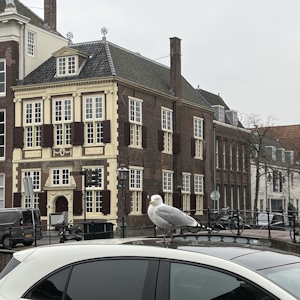 |
Bibliotheca Thysiana was founded by testament by the young Dutch legal expert Johannes Thysius (1622-1653). It is the only Dutch book collection from the seventeenth century housed in the original purpose-built library. The collection contains some 2,500 books and several thousand pamphlets on a great variety of subjects. The collection contains an original Bleau atlas and a Vesalius book on Anatomy. |
Pieterskerk
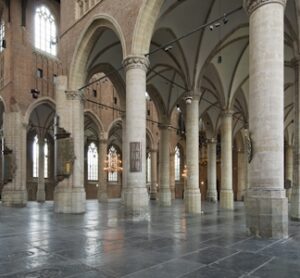
For nearly 900 years, the Pieterskerk has been the heart of Leiden. Once a Catholic and later a Reformed Church, it is now a national monument with exceptional cultural and historical value. The church played a key role in the story of the Pilgrims before their journey to America, and its rich history – which spans centuries – includes visits from Rembrandt van Rijn, John Adams, Winston Churchill, Nelson Mandela, and Dutch royalty.
Boerhaave Museum
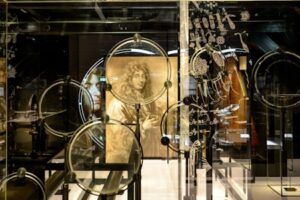 Rijksmuseum Boerhaave, the Netherlands’ treasure house of science and medicine and winner of the European Museum of the Year Award 2019. The museum is located in a historic building in the heart of Leiden: the Caecilia Hospital. In the eighteenth century, this was a hospital where Herman Boerhaave (1668 – 1738) taught bedside medicine. Many Universities copied this type of teaching, which was used when the University of Edinburgh was founded, and subsequently by medical schools in the USA Philadelphia. The idea of first having a Bachelor in medicine and subsequently a Doctor degree, was started here.
Rijksmuseum Boerhaave, the Netherlands’ treasure house of science and medicine and winner of the European Museum of the Year Award 2019. The museum is located in a historic building in the heart of Leiden: the Caecilia Hospital. In the eighteenth century, this was a hospital where Herman Boerhaave (1668 – 1738) taught bedside medicine. Many Universities copied this type of teaching, which was used when the University of Edinburgh was founded, and subsequently by medical schools in the USA Philadelphia. The idea of first having a Bachelor in medicine and subsequently a Doctor degree, was started here.
Academy Building
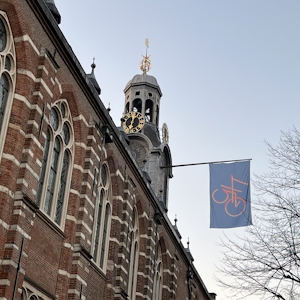 The Academy Building is the oldest building and the heart of Leiden university. While still being used for student lectures, it is mainly used for official celebrations such as PhD ceremonies and orations. The building started as a Chapel for the Dominicaner nuns, and was taken over when the University was founded in 1574. In 1616, the Chapel was separated in two parts, giving rise to the Large and Small Auditorium. In the Large Auditorium are two Chairs, of which the highest one is only used by Professors during their inauguration. In 1632, the roof was used for an observatory. In 1670, the current tower and clock were added. The botanical garden lies directly behind the Academy Building.
The Academy Building is the oldest building and the heart of Leiden university. While still being used for student lectures, it is mainly used for official celebrations such as PhD ceremonies and orations. The building started as a Chapel for the Dominicaner nuns, and was taken over when the University was founded in 1574. In 1616, the Chapel was separated in two parts, giving rise to the Large and Small Auditorium. In the Large Auditorium are two Chairs, of which the highest one is only used by Professors during their inauguration. In 1632, the roof was used for an observatory. In 1670, the current tower and clock were added. The botanical garden lies directly behind the Academy Building.
Hortus Botanicus
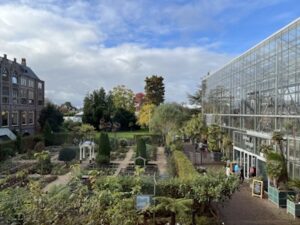 The Hortus Botanicus Leiden is the oldest botanical garden in The Netherlands. The oldest section of the Hortus, dating back to 1590, has been recreated as the current Front Garden. It has been renovated with new plants and in 2000, a new glasshouse was added to form the Winter Garden. The Clusius Garden gives an impression of what the Hortus looked like around 1600, when the bonds between The Netherlands and Asia were formed. Many Asian plants were introduced to Europe through this garden, and the Japanese Garden bears witness to the exchange of plants and knowledge be-tween these cultures. The Hortus’ pride, Victoria amazonica, can be admired in the Victoria Glasshouse. The garden is a place of pure relaxation and beauty, where you can socialize with your friends during one of the shortest nights of the year.
The Hortus Botanicus Leiden is the oldest botanical garden in The Netherlands. The oldest section of the Hortus, dating back to 1590, has been recreated as the current Front Garden. It has been renovated with new plants and in 2000, a new glasshouse was added to form the Winter Garden. The Clusius Garden gives an impression of what the Hortus looked like around 1600, when the bonds between The Netherlands and Asia were formed. Many Asian plants were introduced to Europe through this garden, and the Japanese Garden bears witness to the exchange of plants and knowledge be-tween these cultures. The Hortus’ pride, Victoria amazonica, can be admired in the Victoria Glasshouse. The garden is a place of pure relaxation and beauty, where you can socialize with your friends during one of the shortest nights of the year.
Museum of Antiquities
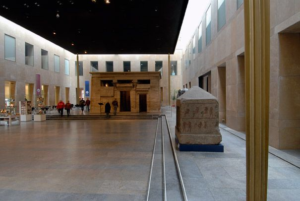
The Dutch National Museum of Antiquities brings archaeology and the ancient world to life. At the museum, everyone can explore the age-old civilizations of Egypt, the Classical World, the ancient Near East, and the Netherlands in prehistoric, Roman, and medieval times. In 2018 the museum celebrated its 200th anniversary.
Plan with AOI 50th Anniversary meeting venues

1. Academy Building, Rapenburg 73, Leiden
2. Rijksmuseum Boerhaave>, Lange Sint Agnietenstraat 10, Leiden
3. Pieterskerk, Kloksteeg 16, Leiden
4. Bibliotheca Thysiana, Rapenburg 25, Leiden
5. Leidse Rederij (start boat tour), Apothekersdijk 5, Leiden
6. Hortus Botanicus, Rapenburg 73, Leiden
7. “Rijksmuseum van Oudheden” / the Dutch National Museum of Antiquities, Rapenburg 28, Leiden
How to get to Leiden
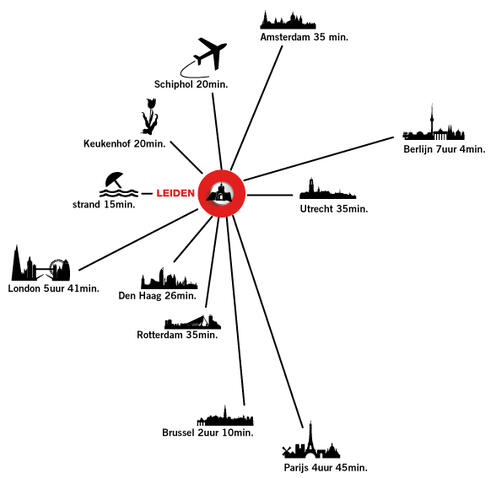 The city is ideally situated; large urban centers such as The Hague and Amsterdam are just a stone’s throw away. The city boasts excellent international accessibility, with Schiphol International Airport Amsterdam at 20 minutes’ distance. The North Sea shore lies 12 kilometres to the west of Leiden.
The city is ideally situated; large urban centers such as The Hague and Amsterdam are just a stone’s throw away. The city boasts excellent international accessibility, with Schiphol International Airport Amsterdam at 20 minutes’ distance. The North Sea shore lies 12 kilometres to the west of Leiden.National and international connections
Website
Leiden is well-connected by train, car and plane. Schiphol international Airport has direct connections to more than 300 locations throughout the world, and it takes only a 15-minute train journey to reach Leiden. The intercity train runs six times per hour. The journey to Leiden is quicker than the journey to Amsterdam, and travellers arrive right in the center of the city, within walking distance of the congress hotel and the other suggested hotels.
Public transport
Train website
Bus website
Leiden is very accessible using public transport. Trains stop at Leiden Central Station from several directions. From this station, travellers can stroll right into the city centre. Most places in Leiden are within walking distance. Buses run frequently, to practically every location in the city.
Museum Boerhaave and the Academy Building have regular bus connections with Leiden Central Station. Details of your bus itinerary can be seen and downloaded via https://9292.nl/en. In the destination field please fill out respectively ‘Museum Boerhaave’ or ‘Academie Gebouw’.
Car
Leiden is situated between two large motorways, the A4 and the A44. Cars can park on Haagweg, at the edge of the city centre. From there, free shuttle buses depart to every destination in the city, and visitors can be picked up with just one phone call.
Canals circle and cut through Leiden’s monumental centre. Almost all locations and hotels are within walking distance of each other, and most are also easily accessible by boat.
